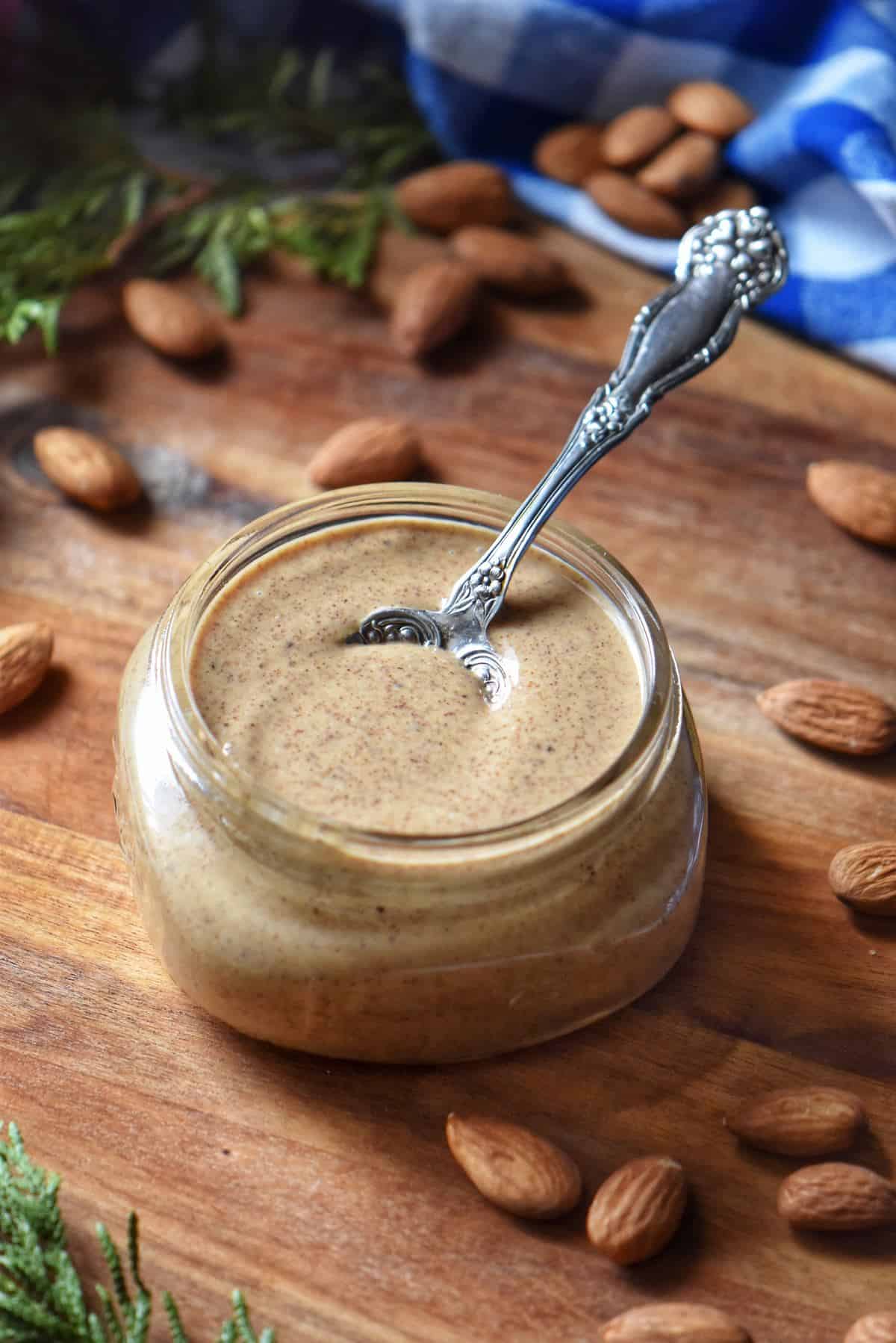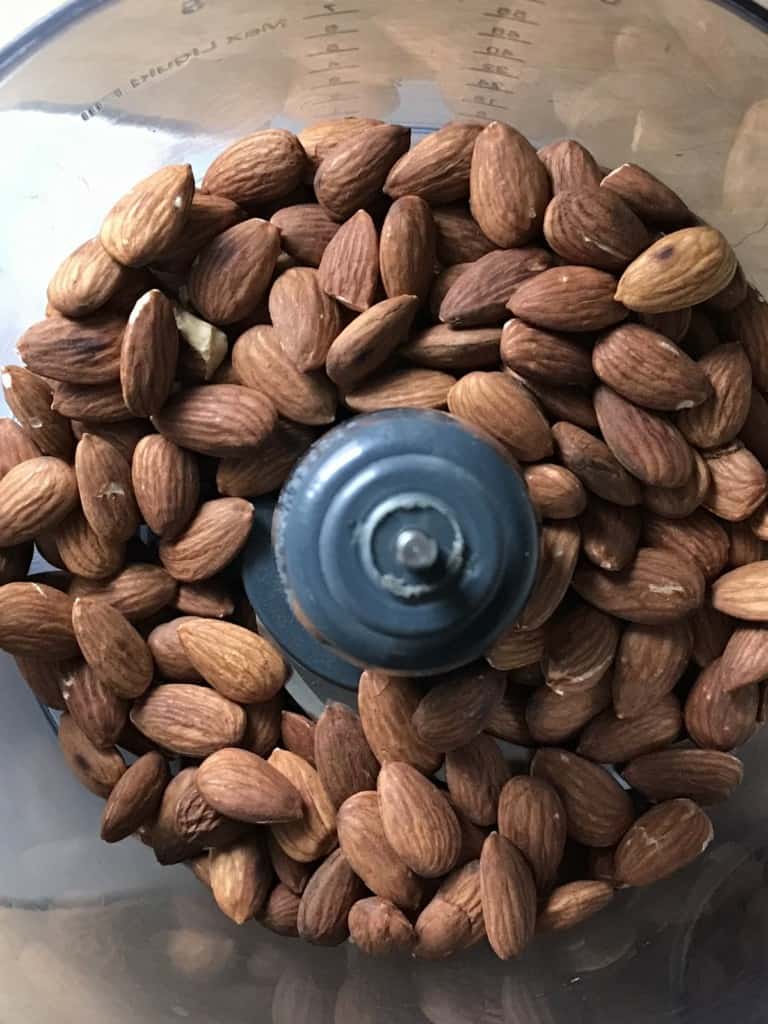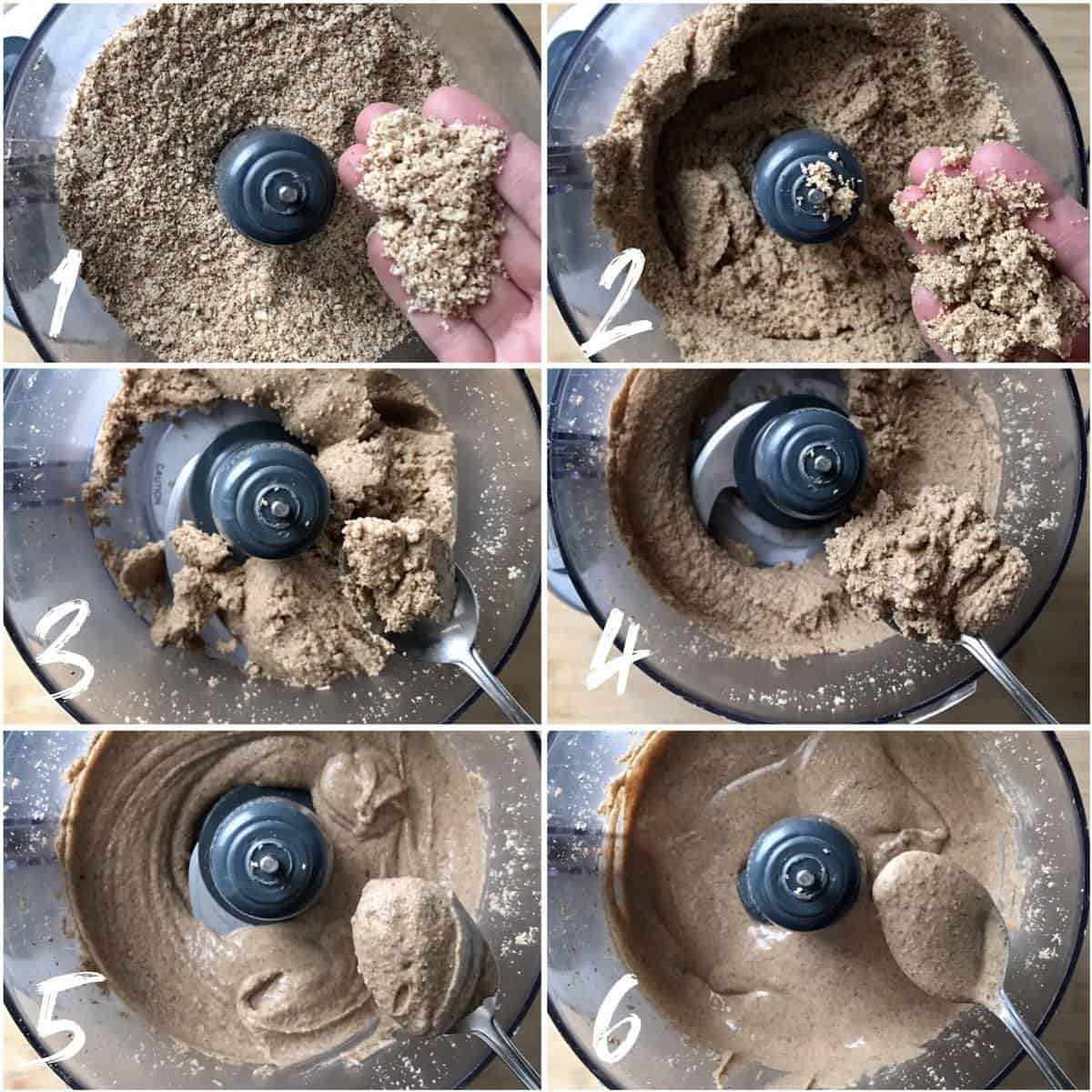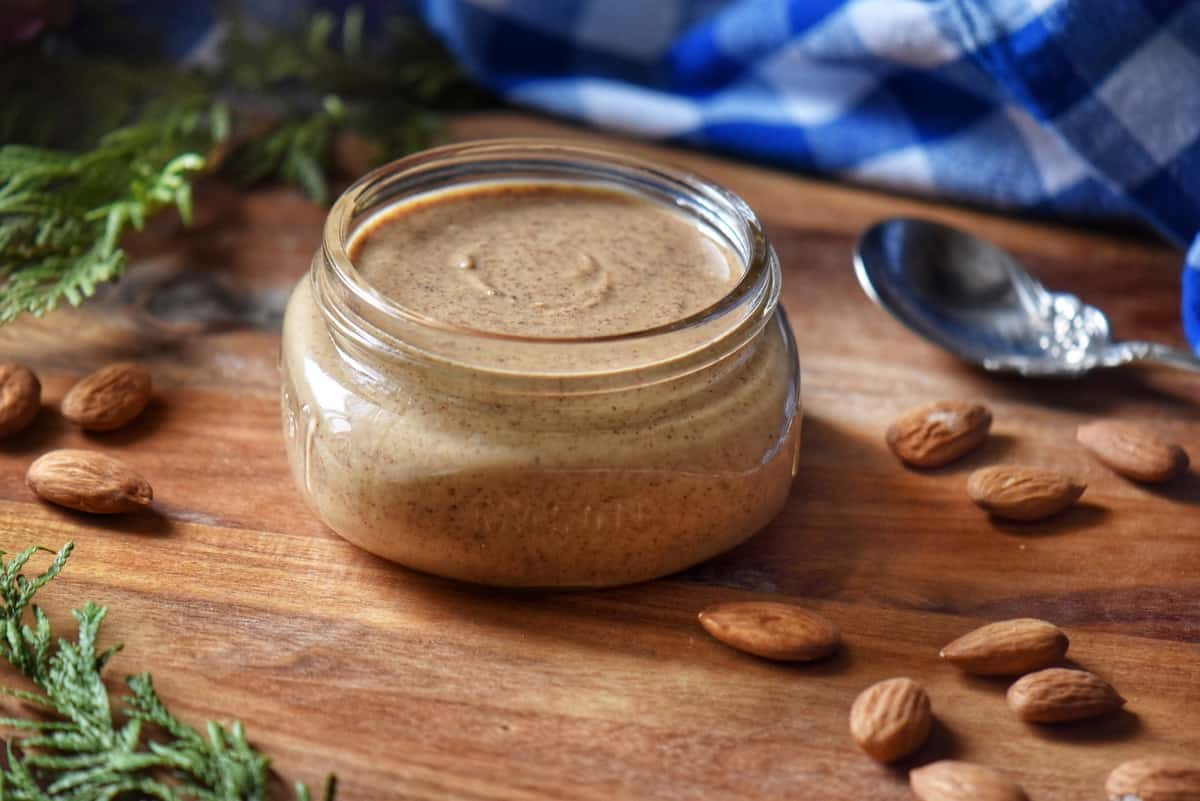Make rich, creamy homemade almond butter in no time! Enjoy a delicious, healthy spread at home with just one ingredient and a food processor.

Want to make rich, creamy homemade almond butter? It’s easier than you think—and you only need one ingredient!
With just roasted almonds and a food processor, you can whip up smooth, spreadable almond butter in about 45 minutes—most of it hands-off!
This homemade version is healthier, fresher, and more affordable than store-bought. Plus, it’s incredibly versatile! Spread it on toast, swirl it into oatmeal, or my favorite way is to make these almond butter chocolate chip cookies!
The truth is that you can have a spoonful or two of this stuff straight from the jar.
Seriously, you won’t believe how amazing it tastes.
If you’ve ever wondered how to make almond butter from scratch, this simple step-by-step guide will show you exactly how. Be sure to watch the video in the recipe card to witness the texture transformation as you process the almonds!
Let’s get started!
Jump to:
How Long Does It Take to Make Almond Butter?
The best part about making this almond butter recipe? Most of the time is hands-off! Here’s a breakdown:
- Roasting the almonds (optional but recommended): 10-15 minutes
- Cooling Time: 10 minutes
- Blending Time: 15-20 minutes (varies based on food processor power)
- Total Time: ~30-45 minutes (including roasting and cooling, if applicable)
By the time you clean up and grab a jar, your food processor will have done all the hard work. Let’s get started!
How to Roast Almonds
To make the best almond butter, you must first roast your nuts. Roasting them might seem like an extra step, but it’s essential since we want a tasty almond spread! Here are the easy steps:
- Adjust the oven rack to the middle of the oven.
- Preheat the oven to 325°F (162°C).
- Spread the almonds in a single layer on a rimmed baking sheet and roast for 10-15 minutes or until fragrant.
- Move almonds around a few times while they are roasting.
- Transfer the pan to a wire rack and cool down for about 10 minutes. They should still be warm.

Step-by-Step Directions
- Prepare the Almonds: Place 3 cups (about one pound) of slightly warm roasted almonds in a food processor.
- Start Processing: Process the nuts at medium-high speed for about 15-20 minutes. Be patient!
- Add Salt (if desired): If you like, add a pinch of salt towards the end of the processing.
- Transfer and Store: Once smooth, transfer the almond butter to a sterile mason jar and refrigerate.

Let’s Take a Closer Look at the Process
- Begin by pulsing the roasted almonds for a few minutes until you achieve a texture similar to almond flour.
- As you continue processing, you’ll notice the ground almonds sticking to the sides of the bowl. Be sure to scrape down the sides periodically.
- After a few more minutes, the ground almonds will start to clump together and move as a mass due to the oils being released.
- The mixture will begin to take the form of a spread, although it will still be grainy.
- Keep processing, stopping occasionally to prevent the food processor from overheating.
- Eventually, the almond butter will become smooth and creamy with a fluid consistency from the warm almond oil.
This is the best time to “pour” the almond butter into sterile mason jars. Allow it to cool to room temperature before storing it in the refrigerator.

Tips
- Use Blanched Almonds: For an even creamier almond spread, opt for blanched almonds.
- Let Your Processor Rest: Allow your food processor to rest every few minutes to prevent overheating.
- Adjust Roasting Times: Keep in mind that roasting times may vary as ovens heat differently.
- Cool Before Processing: DO NOT process almonds while they are still hot to avoid damaging your blender.
- No Added Oil Needed: Warm roasted almonds release their oils quickly, so there’s no need to add extra oil.
- Be Patient: Depending on the type of food processor you have, it can take up to 20 minutes for the almonds to transform into smooth, thick and creamy almond butter.
- Scrape Down the Sides: Regularly scrape down the sides of the bowl to ensure an even consistency.
- Store Properly: Use a sterile jar and lid to maximize the storage period of your almond butter.
What to Make with Almond Butter

Almond Butter Cookies
Would you like a cookie without the hassle of butter or flour? Making these gluten-free almond butter chocolate chip cookies is quick, easy, and delicious! The perfect cookie recipe to make with homemade almond butter!
FAQ
Although it can be stored at room temperature, it is recommended to store homemade almond butter in the refrigerator for best results and a longer storage period. This is because there are no preservatives that help to extend the shelf life.
Yes! Mix in a handful of chopped roasted almonds with your nut butter.
Roasting blanched almonds is not necessary, but it is recommended. Roasting enhances the flavor and helps achieve a creamier texture. If you choose to roast them, a quick 10-12 minutes at 325°F (162°C) works well.
Unfortunately, adding these liquids (including vanilla extract) may cause the almond butter to seize, resulting in nut butter clumps.
Recipe Inspiration
I still vividly remember the excitement I felt the first time I made almond butter with my brand-new Cuisinart food processor. That natural transformation from whole almonds to creamy goodness still amazes me today!
Even though I no longer have that same appliance, I continue to enjoy making fresh almond butter regularly.
I have a soft spot for all nut butters, especially my favorite chocolate hazelnut butter. If you’re curious about making your own, check out my hazelnut butter recipe for another delicious option!
Have you tried making different nut butters?
As you can see from my ingredient list, I prefer not to add any oil, but feel free to experiment if you like! The beauty of homemade nut butter is that you can customize it to your taste.
And don’t forget—this is a fantastic weekend project to do with the kids! It’s a fun way to teach them about cooking and healthy eating.
Have fun, and I’d love to hear about your nut butter adventures!
THANKS SO MUCH for following and being part of the She Loves Biscotti community, where you will find Simple & Tasty Family-Friendly Recipes with an Italian Twist.
Ciao for now,
Maria
★★★★★ If you have made this almond butter recipe, I would love to hear about it in the comments below, and be sure to rate the recipe!
Recipe

Homemade Almond Butter
WANT TO SAVE THIS RECIPE?
Ingredients
- 3 cups almonds roasted, with or without skin
- pinch salt optional
Instructions
- Place slightly warm roasted almonds in the food processor.
- Process nuts at medium-high speed for about 15-20 minutes.
- Scrape the sides of the bowl every couple of minutes.
- Be patient 🙂
- If desired, add a pinch of salt at the end of the process.
- Transfer to a sterile mason type jar, allow to come to room temperature and then refrigerate.
- WATCH THE VIDEO ON THE RECIPE CARD TO SEE HOW EASY THIS RECIPE IS TO MAKE!
Video
Notes
- Use Blanched Almonds: For an even creamier almond spread, opt for blanched almonds.
- Let Your Processor Rest: Allow your food processor to rest every few minutes to prevent overheating.
- Adjust Roasting Times: Keep in mind that roasting times may vary as ovens heat differently.
- Cool Before Processing: DO NOT process almonds while they are still hot to avoid damaging your blender.
- No Added Oil Needed: Warm roasted almonds release their oils quickly, so there’s no need to add extra oil.
- Be Patient: Depending on the type of food processor you have, it can take up to 20 minutes for the almonds to transform into smooth, thick and creamy almond butter.
- Scrape Down the Sides: Regularly scrape down the sides of the bowl to ensure an even consistency.
- Store Properly: Use a sterile jar and lid to maximize the storage period of your almond butter.
Nutrition
This post was originally published on October 30, 2014, and republished on January 7, 2021, and again on February 10, 2025 with updated content and a video.



Maria
how much is one serving? one tablespoon or more?
Maria
Great question Maria! 1 serving of almond butter is the equivalence of 1 tablespoon. I will update the recipe card. Thanks for asking 🙂
Carmela Nardelli
Recipe book
Hi Maria!
Can you tell me. Do you have a cookbook out, that I can purchase
Maria
Hi Carmela! Thanks so much for your interest and support! I am presently working on some ebooks for now… baby steps.